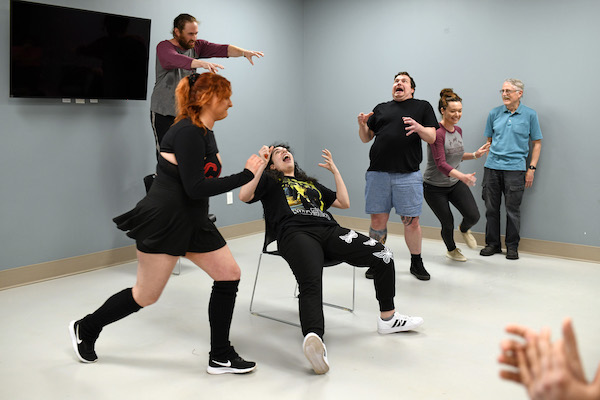
The Weird or Unusual Thing
Once we’ve established the necessary information in our scene—who we are, where we are, what we’re doing, and how we feel about it—it’s time to establish the weird or unusual thing that we’re going to be focusing on. This weird thing is going to be the catalyst for our game, the “what we’re doing” of the scene. In fact, finding the weird thing and bear hugging it are both part of the concept of “playing the game”. So how do we find it?
How to Find the Weird or Unusual Thing
Pay attention. End of lesson. Finding the weird or unusual thing is all about being present and open minded in our scene. If we do that, we are much more likely to notice when something is out of the ordinary. It’s important to remember that weird or unusual for our improv scene is not necessarily the same as weird or unusual for the world outside of our scene. If the context of the scene is absurd or strange, a normal thing might seem weird by comparison. We have to understand the world we’ve created before we can know what is unusual within it. Another key element of the search for the weird or unusual thing is that it doesn’t have to be a search at all—we can decide what’s weird in our scene, because we’re creating it on the spot! Often the way we communicate the weird thing is by having a big emotional reaction to it, and we’re free to have a big emotional reaction to anything that moves us. We can decide that the way a character is stirring the soup in a pot is unusual, and by doing so, we’ve found the thing that we’re going to bear hug and heighten as the scene goes along.
What to Do with the Weird or Unusual Thing Once We’ve Found It
Congratulations, you were paying attention in the scene and you found the weird thing, now what? First, we have to communicate to our scene partner and the audience that we believe this thing is weird or unusual. As mentioned above, we often do this by having a strong emotional reaction to that thing, but that’s not the only way to indicate the weird thing. We can also simply call it out, saying in no uncertain terms that our character believes that this thing is unusual in the world we’ve created. We do not, and should not, be coy—the more direct and clear the better. A great teacher of mine, James Hamilton (no relation), once said that no one has ever left an improv show saying, “That was funny, but they were real specific about things.” Be obvious, it makes it easier for everyone.
Once we agree on what the weird or unusual thing is, we bear hug it. That is, we focus on that thing in all its permutations and stop worrying about other things that may have been added to the scene. We do not care about narrative in improv. I don’t care if we get to the logical end of the scene, or the resolution of the transaction—that’s not what’s funny about the scene. We want to take that weird or unusual thing and play with it until we run out of ideas, or the audience erupts in laughter so disruptive that we have to edit the scene. This knowledge should provide us with some comfort, once we’ve found the weird or unusual thing and communicated it to our scene patterns and the audience, all that’s left for us to do is play!
